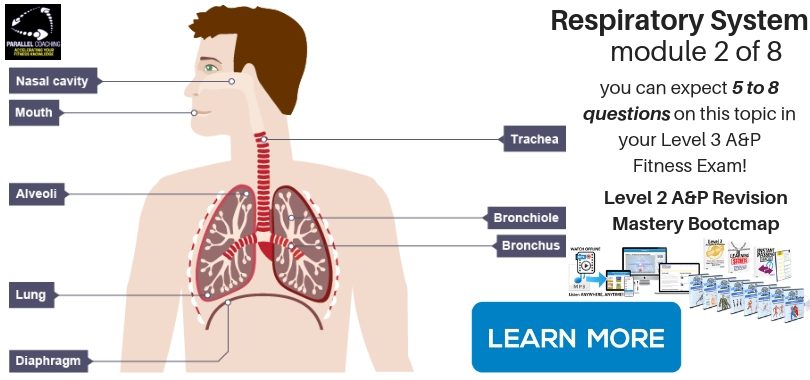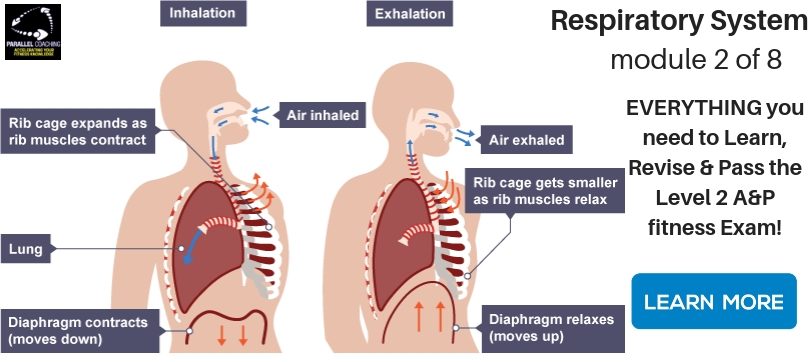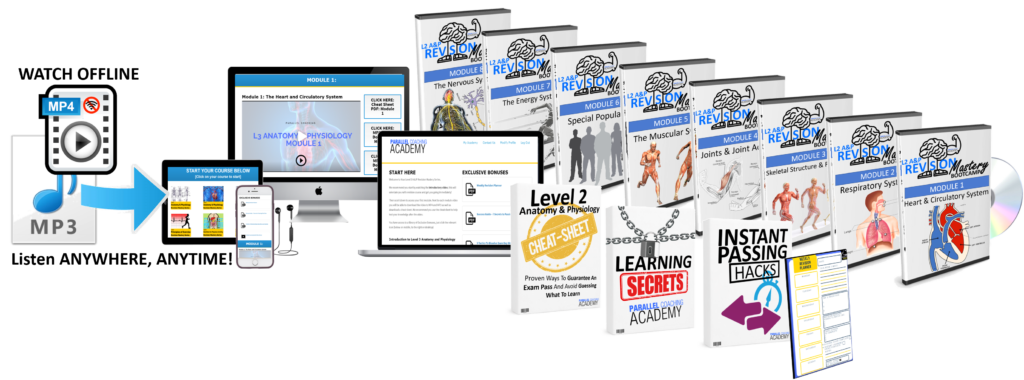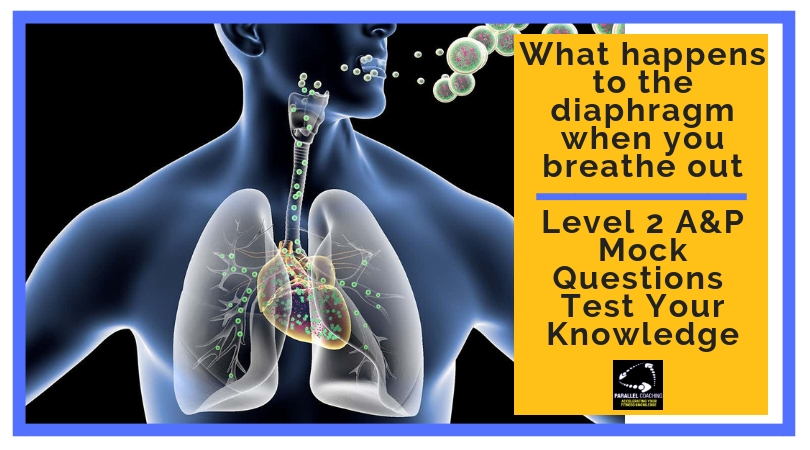This blog will teach you EVERYTHING you need to know about the Diaphragm when you breathe out in preparation for your level 2 anatomy exam.
You’ll discover:
- Why do you need to know about the diaphragm?
- Structure of the respiratory system
- Passage of air into the lungs
- Breathing in and out
- What is diagrammatical breathing
- Three Example Mock Question about the Respiratory System and Diaphragm
Why do you need to know about the diaphragm?
As part of the Level 2 Anatomy exam, you need to know about the respiratory system and what happens to the diaphragm when you breathe out.
Plus you’ll need to know about the diaphragm and breathing as a teaching point when training clients
The Respiratory system is module 1 of the Level 2 Anatomy & Physiology fitness exam.
In level 2 A&P you must know the muscles that assist with the respiratory system.
Simply put…
The respiratory system transports oxygen from the air we breathe, through a system of tubes, into our lungs and then diffuses it into the bloodstream, whilst carbon dioxide makes the opposite journey.
Structure of the respiratory system

Passage of air into the lungs
1️⃣ Air enters the body and is warmed as it travels through the mouth and nose.
2️⃣ It then enters the trachea.
3️⃣ The trachea divides into two bronchi. One bronchus enters each lung.
4️⃣ Each bronchus branches out into smaller tubes called bronchioles. Air travels through these bronchioles.
5️⃣ At the end of the bronchioles, the air enters one of the many millions of alveoli where gaseous exchange takes place.
Breathing
Breathing is the term given to the process of taking air into and out of the lungs.

👆🏻 The process of inhalation and exhalation
Further Reading
Here another Parallel Coaching blog to HELP:
Anatomy Quiz [Understanding the Respiratory System]
Two important structures for breathing are the diaphragm and intercostal muscles.
The diaphragm is a sheet of muscle that separates the chest (or thoracic) cavity from the rest of the body. The intercostal muscles are found between the ribs and they control rib movement.
Inspiration (breathing in)
The diaphragm contracts and moves downwards.
The intercostal muscles contract and move the ribs upwards and outwards. This increases the size of the chest and decreases the air pressure inside it which sucks air into the lungs.
Expiration (breathing out)
The diaphragm relaxes and moves up to its domed shape.
The intercostal muscles relax so the ribs move inwards and downwards under their own weight. This decreases the size of the chest and increases the air pressure in the chest so air is forced out of the lungs.
Here’s Why the Way You Breathe During a Workout Matters! 🧐
There are multiple variables in a client session to improve their performance. One of those small ninja tweaks that can make a big difference is paying attention to their breathing.
Breathing is something you are born knowing how to do, and your body typically does it on autopilot.
Simply ah?
But is your client breathing right and getting the most out of every breathe?
Each time you inhale, you take in oxygen, which your body needs to function. The more that you move, the more oxygen you need.
We want our client to be focusing on something called diaphragmatic breathing.
Your diaphragm is a muscle located between your thoracic cavity (chest) and abdominal cavity, and it should be the main workhorse that powers your breathing.
Yet many clients don’t fully engage this muscle when breathing, and instead take shorter, more shallow breaths that begin and end in the chest.
Breathing in this shallow way, the client won’t be able to deliver as much oxygenated air to your lungs. This increases their heart rate and blood pressure, which can ultimately increase feelings of anxiety and stress, and even make them feel short of breath.
Thus the client does not enjoy the session or want to come back next time!
This simple ninja tweak could be all you need to have happy clients return time and time again!
What is Diaphragmatic breathing?
Diaphragmatic breathing engages the diaphragm muscle with every breath.
It involves slowly breathing in through the nose or mouth (preferably the nose), filling up your abdominal area (versus your chest) with air, and then slowly exhaling as the stomach collapses.
When exercising, diaphragmatic breathing can help ensure core activation and that your client is breathing deeply enough to deliver enough oxygen to the working muscles, which prevents the client from fatiguing early.
Final point…
Breathing is second-nature for everyone. Meaning that it does require strength and effort for your body to perform correctly. However, guiding your client towards diaphragmatic breathing is a key teaching point regardless of their starting point.
Aim to guide your client to always exhale on exertion. For example, when they are pushing a bench press concentrically, you exhale on the push.
and inhale as you bring it slowly back to the chest on the eccentric phase.
And together, correct breathing and the correct use of the diaphragm impact the mechanics of the entire body.
This is why you MUST know your Anatomy & Physiology inside and out!
In summary
- The Respiratory system is module 1 of the Level 2 Anatomy & Physiology fitness exam.
- In level 2 A&P you must know the muscles that assist with the respiratory system.
- The respiratory system transports oxygen from the air we breathe, through a system of tubes, into our lungs and then diffuses it into the bloodstream.
- There are two important structures for breathing are they the diaphragm and intercostal muscles.
- Diaphragmatic breathing is key to get the most out of every exercise your client performs
- Here’s what Karen had to say about the A&P Revision Mastery Bootcamp 👇 👇 👇
Fantastic content that is easy to use and helps breakdown complex subjects in to a easy to learn format. The team are Super professional yet so friendly and engaging. I look forward to my daily questions and videos. Keep up the amazing work !!!!!
Karen B
Test your knowledge with today’s mock questions:
[NOTE: The answers are below the 3rd questions]
1. What happens to the diaphragm during exhalation?
A. Relaxes and moves down
B. Relaxes and moves up
C. Contracts and moves up
D. Contracts and moves down
2. During inhalation, where does air flow to, after leaving the trachea
A. Bronchus
B. Alveoli
C. Pharynx
D. Oesophagus
3. Which two muscles are primarily responsible for breathing action?
A. Pectoralis Major and Latissimus Dorsi
B. Pectoralis Major and Intercostal Muscles
C. Latissimus Dorsi and Diaphragm
D. Diaphragm and Intercostal muscles
Answers to the mock questions are :
Question 1= B, Question 2 = A, Question 3 = D
If you want more mock questions like this, then you can download more Free Mock Questions: DOWNLOAD NOW
Need More Help with your Level 2 Anatomy Revision?
Discover How 6500+ Fitpros In Training Are Walking Into Their Exam With Confidence And Guaranteeing A Pass
Are you tired of staring at your manual and not knowing where to start?
Our revision mastery bootcamp breaks everything down into a clear and easy to follow structure.
You can download the videos to MP3 and MP4 to slice your revision time in half and finally understand the key principles of exercise.
This is not another course with more exams – it HELPS pass the course you’re already enrolled on!
“EVERYTHING You Need To Learn, Revise And Pass Your Fitness Exam”
If you want to get your revision structured, learn everything you need to know and feel confident on exam day, then click the link below:
https://revision.parallelcoaching.co.uk/l2-anatomy-and-physiology-revision-mastery

Dedicated to More
Hayley “Diaphragm” Bergman
Parallel Coaching
P.S. You can also find us on the following platforms:
Instagram: Follow Now
Facebook: Like Our Page
Twitter: Tweet Us
YouTube: Subscribe Here
More Anatomy Revision Blogs: HERE

